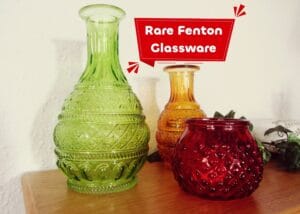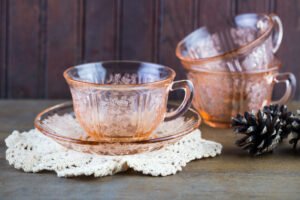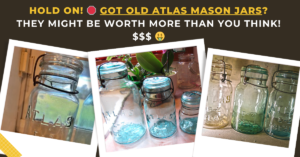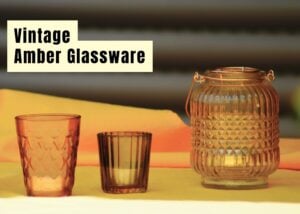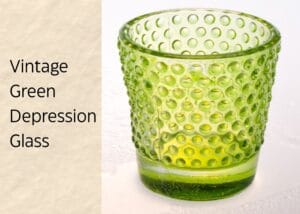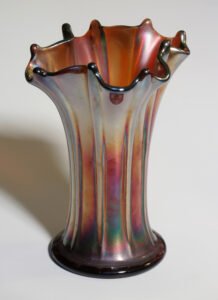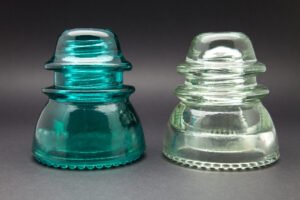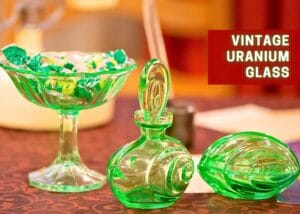Did you know that a rare mosaic glass vase from Fenton sold for a whopping $5,000 in an online auction? And no, that’s not a typo! While most vintage glassware collects dust (just like that glass figurine in your china cabinet), authentic Fenton glassware pieces are making headlines with rare specimens fetching jaw-dropping prices!
In this guide, I’ll show you some of the rarest and most valuable Fenton glass items that might be hiding in your home right now! Plus, you’ll learn how to spot genuine Fenton treasures and what really makes them worth the money!
1. Fenton Mosaic Art Glass Vase

This jaw-dropping piece represents Fenton’s experimental artistic peak during the Roaring 20s. This cobalt-based vase features a freehand mosaic pattern where the glassmaker applied chunks of different colored glass to create that wild, abstract design.
Then, thin glass threads were wrapped around it while still hot. Those three applied “legs” at the bottom are functional but also add sculptural interest. The intense color saturation, unlike most surviving examples with more subdued hues, justifies the $1,650+ price tag, against the average value of $600-$1,200!
2. Fenton Pan the God Vaseline Glass Mask
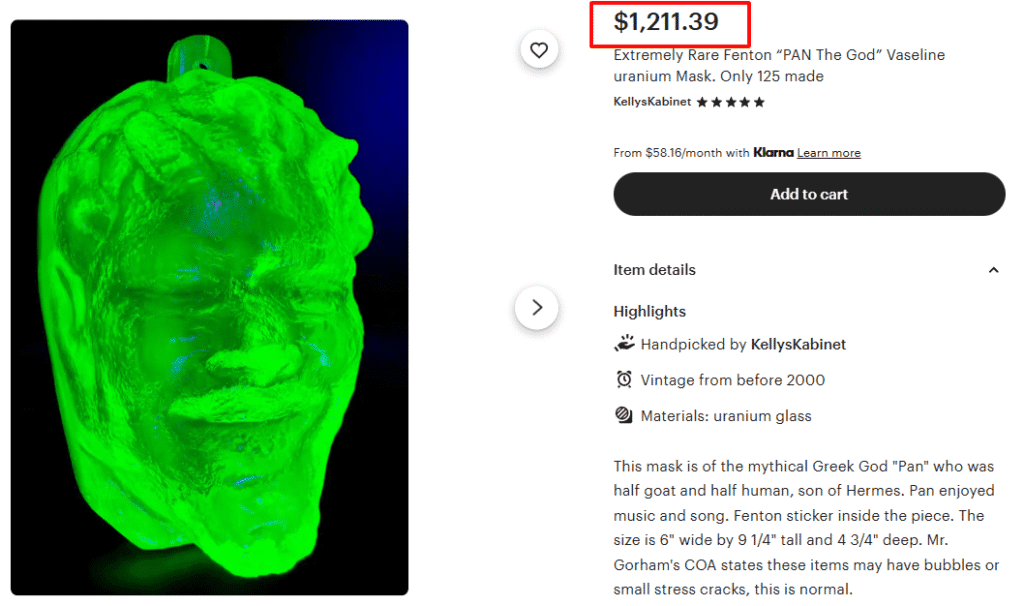
This breathtaking Fenton “PAN The God” mask showcases the company’s artistic pinnacle from the late 1990s. Standing 9¼ inches tall and crafted in vaseline uranium glass, this sculpture depicts the Greek god Pan with remarkable detail, glowing an electric green under UV light.
With only 125 ever produced (according to the included Fenton sticker and certificate), it represents one of their rarest pieces. Created by master artist Dave Fetty during Fenton’s experimental phase, its $1,211.39 price reflects its documented scarcity and investment potential.
This mask depicts the mythical Greek God “Pan,” son of Hermes, who was half goat and half human.
3. Fenton Gone With The Wind Art Glass Lamp

This impressive 30-inch “Gone With The Wind” style lamp showcases why Fenton dominated the decorative glass market for decades. The term GWTW refers to these two-globe electric lamps with brass accents inspired by Victorian oil lamps popular during the Civil War era (think Scarlett O’Hara’s mansion).
The embossed cabbage rose pattern on cream-colored “Custard glass” with that striking pink ruffle top was one of Fenton’s most popular 1950s designs. Fenton began producing these substantial statement lamps in the late 1940s through the 1960s!
Finding these large pieces in pristine condition is quite rare – many didn’t survive intact because they’re so top-heavy and fragile. So, the $950 price reflects both rarity and condition!
4. Fenton Electric Blue Parkersburg Elks Carnival Glass Plate
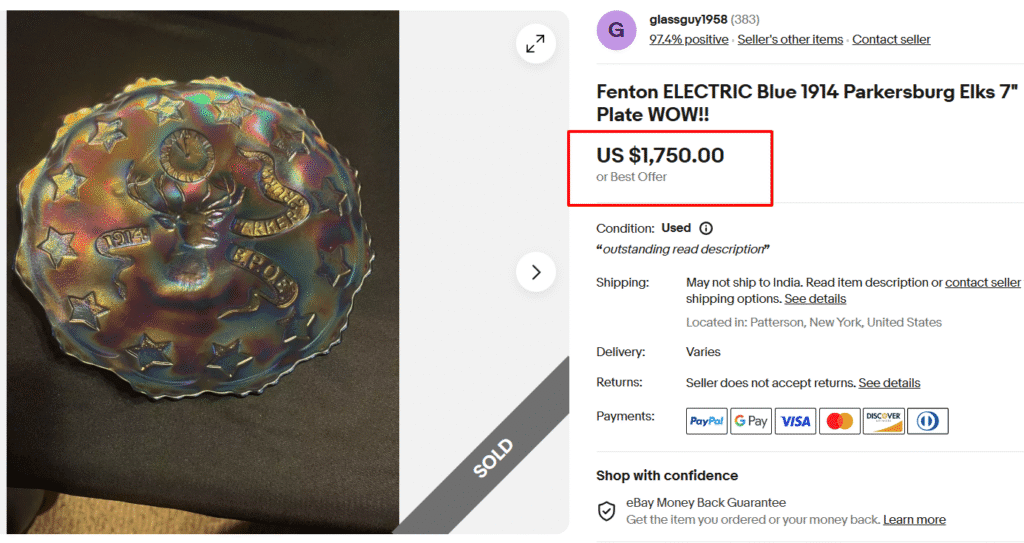
Now THIS is the holy grail for Fenton collectors! This 7-inch commemorative plate was made specifically for the Parkersburg, West Virginia Elks Lodge in 1914. The electric blue carnival glass base showcases embossed motifs of the clock face, stars, the Elks emblem, and the specific year.
Such commemorative pieces were commissioned by organizations in extremely limited quantities, making them incredibly rare today. Besides, the “electric blue” was the most desirable and scarce carnival glass color Fenton produced.
5. Amberina Slag Glass Alley Cat
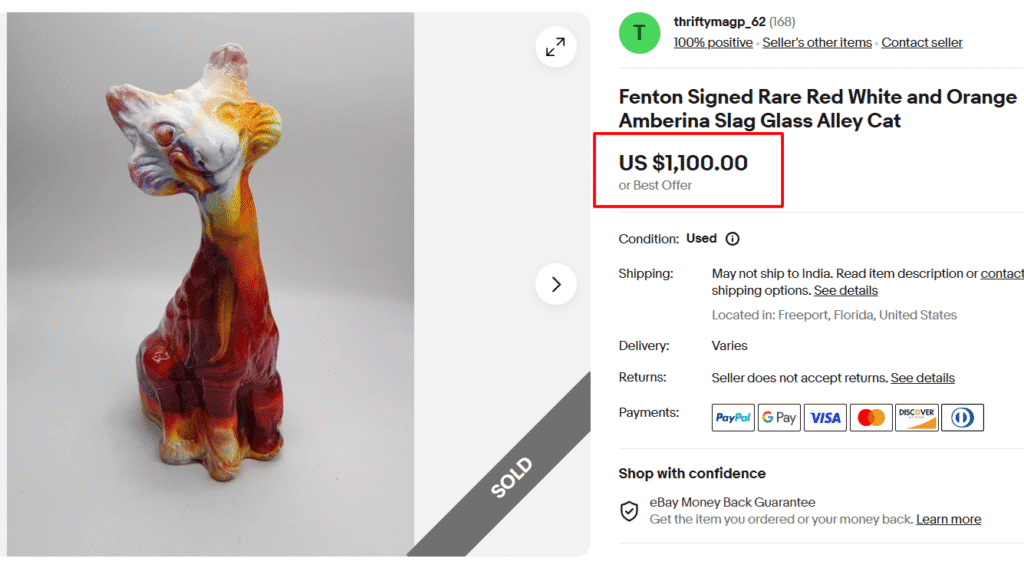
This stunning cat figurine showcases Fenton’s mastery of “slag glass” – a technique where multiple colors are swirled together while the glass is molten. The dramatic color transition from white face down to rich red body with golden highlights is technically called “amberina,” a specialty color combination Fenton perfected.
Fenton’s animal figurines became hugely popular in the 1970s-80s, with their cats being particularly sought after. The “alley cat” design, with its elongated neck and stylized features, became one of its signature animal designs. Most of Fenton’s animal figurines sell in the $100-300 range, but this unique combination is rare, sold at $1,100!
6. Rare Fenton Topaz Opalescent Bridesmaid Pair (Signed)

These graceful bridesmaid figures in that glowing topaz (yellow-green) opalescent glass are highly sought after by collectors. What makes this pair extra special is that they’re numbered (94 and 100 of a limited run) and signed by Fenton artists Joyce Colella and Mary Walrath!
Fenton introduced their bridesmaid figurines in the 1980s, but these specific limited editions are from the early 2000s (as per artist signatures). The opalescent effect creates that gorgeous semi-transparent look with subtle color shifts, and the hand-painted floral details on their dresses add that signature Fenton touch.
The $750 price for the matched pair makes sense – individually, these typically sell for $300-400 each!
7. Fenton Hand-Carved “Deco Deer” Burmese Cameo Vase

What makes this vase special is that it represents Fenton’s later artistic renaissance. Created in 2007 (near the end of Fenton’s production era), this is part of their limited “studio art glass” line, where master carvers like Kelsey Murphy and Robert Bomkamp transformed factory pieces into one-of-a-kind art.
This is a numbered edition (30/325), that means only 325 were ever made. It features a technique called “cameo carving” – multiple layers of glass (pink over pale yellow here) are selectively carved away to create dimensional designs using sandblasting with hand-cut rubber resist patterns.
Rare cameo-carved Fenton pieces from this period typically sell between $500-900.
8. Fenton Burmese Fairy Poinsettia Art Glass Lamp

Fenton’s Burmese glass is instantly recognizable by its dreamy pink-to-yellow gradient – the technical term is “thermally reactive,” which means the glass changes color when reheated during production. The delicate hand-painted poinsettia design with those red berries really pops against the soft background.
Fenton introduced Burmese glass in 1970 as a revival of an 1880s English glass technique, and it quickly became one of their signature looks. These weren’t made in huge numbers because of the multi-step process, making these rather rare today!
9. Fenton Carnival Persian Medallion Three Piece Lamp

I’ve got a smaller version of this fairy lamp on my nightstand! This three-piece lamp design combines a crimped base, the intricate Persian Medallion patterned bowl, and a smooth top piece.
The red-purple coloration (collectors call it “amethyst”) shows off that spectacular iridescent carnival finish that creates rainbow highlights against the deep purple background. This Persian Medallion pattern was introduced in the 1940s and has remained one of Fenton’s most popular designs.
10. Fenton “Stretch Glass” Iridescent Epergne

Fenton’s epergnes (pronounced “eh-PERN”) are a collector’s charm, especially in a carnival glass color as rare as the ruby! The ruby red formula was one of Fenton’s most successful carnival glass colors. Epergnes are essentially fancy flower holders with multiple vases combined.
This 13-inch showstopper features that classic deep ruby base with iridescent “carnival” finish that shifts colors as light hits it. The trumpet shapes create dramatic ruffled edges throughout the five-piece design. These pieces typically sell for $300-$600!
11. Fenton Swung Vase

Fenton’s swung vases have a following of their own! This tall, slender piece showcases unmistakable uranium-infused vaseline glass that glows neon green under blacklight. What makes it special is the combination of hobnail texture with the opalescent effect, where the glass transitions from creamy at the crimped top to that yellow-green at the base.
Fenton produced these swung vases primarily in the 1950s-60s. This pre-logo example (made before 1970 when Fenton started marking pieces) stands about 12 inches tall, much larger than typical 8-inch versions that sell for $200-300.
To create a “swung vase,” the glassmaker would create a basic shape, then literally swing the molten glass in a circular motion to stretch it taller – no two are exactly alike!
12. Pink Milk Glass Silvercrest Cake Stand

This elegant Fenton Pink Milk Glass Silvercrest Cupcake Stand represents one of their most sought-after color combinations from the mid-century period. With a delicate crimped edge, it features Fenton’s signature “Silvercrest” pattern – a striking design where white milk glass (called “crest”) is applied over colored glass (in this case, a soft pink).
This particular pink shade was produced primarily between 1953-1959, making it considerably rarer than the more common white or blue Silvercrest pieces. The graceful pedestal base and scalloped rim represent Fenton’s meticulous craftsmanship.
Pink Silvercrest typically commands a 30-40% premium over comparable white milk glass items because of its limited production run.
How to Identify Real Fenton Glass? (Key Signs to Spot)
So, you’ve found a pretty piece of glass and you’re wondering if it’s Fenton and if it’s rare! Here’s what you need to look for:
Fenton’s Marks & Labels
Tracking down Fenton marks is like a mini history lesson. Before 1970, Fenton mostly used paper labels that were easily lost over time. If you find a piece with its original paper label intact – that’s special!
Some notable paper labels are:
- Blue Paper Label (1957-1971): Featured a glass maker illustration with the words “Authentic Fenton Handmade”
- Black & Gold Paper Label (1970-1985): Similar design with a glass maker and “Authentic Fenton Handmade” text
- Various Earlier Labels (1921-1957): Including silver on ivory (1925), silver with greenish-yellow background (1939-1948), and other color combinations
From 1970 onward, Fenton started marking most pieces with “Fenton” in cursive inside an oval, stamped right into the glass. This makes identification much easier!

In the 1980s, Fenton began adding a number under the “n” in the logo to indicate the decade. Here’s a quick dating guide based on this number:
- Just “Fenton” in an oval: 1970-1979
- “Fenton” with number “8” below: 1980s
- “Fenton” with number “9” below: 1990s
- “Fenton” with number “0” below: 2000-2009
- “Fenton” with number “1” below: 2010-2011
If you see a script “F” in an oval, that’s from pieces made with molds Fenton bought from other companies around 1983, such as Verlys, McKee, U.S. Glass, or Paden City.
Don’t be discouraged if your piece doesn’t have a mark! Many early Fenton pieces weren’t marked at all, and paper labels often fell off over the years. That’s when knowing the typical styles and patterns becomes super helpful.
Fenton’s Famous Glass Types
Fenton created so many beautiful types of glass over the years. Here are the stars of the show:
- Carnival Glass – This was Fenton’s first big innovation in 1907. It has that distinctive iridescent rainbow finish that reminds you of oil on water. Popular colors were marigold (orange), purple, blue, and green.
- Hobnail Glass – Introduced in 1939, this is probably what most people picture when they think of Fenton. It’s covered with those cute button-like bumps. While it started in translucent colors, the white milk glass version introduced in 1950 became their signature look.
- Milk Glass – This opaque white glass became wildly popular in the 1950s-70s. Here’s a cool trick: if you hold an older milk glass (pre-1958) up to sunlight, you’ll see a colorful halo effect called the “ring of fire.” Newer pieces don’t do this!
- Opalescent Glass – This beautiful glass is transparent colored glass with milky white edges. French opalescent (clear with white edges), blue opalescent, and cranberry opalescent are particularly stunning.
- Crested Glass – These pieces have contrasting color edges, like the popular “Silver Crest” pattern, with clear ruffled edges on colored glass.
- Custard Glass – The custard has a rich, creamy yellow color ranging from pale ivory to bright yellow-green. It’s often decorated with gold trim or painted flowers. Collectors love rare custard glass pieces!
- Stretch Glass – Iridescent glass with a pulled or “stretched” effect, often with ribbed or crimped edges.
Fun Fact: Fun fact: older carnival glass pieces often have tiny air bubbles or carbon specks and collectors actually value these “imperfections” as proof of authenticity!
Authentication Signs
Here are a few more things I check when hunting for authentic Fenton:
- Edge finishing – One of the first things I look for is the edge of the piece. Fenton loves a good ruffle! Their vases, bowls, and baskets often have these gorgeous, flowing, crimped edges that look like rippling ribbons. They’re not just pretty – they’re a Fenton calling card.
- Weight – Feel the weight! Authentic Fenton has substance to it – not too heavy, not too light, just perfectly balanced. The glass should feel smooth (except for intentional patterns), and colors should pop with vibrancy.
- Pontil marks – Most Fenton pieces don’t have pontil marks (rough spots on the bottom where the piece was attached during production). If you see one, it might be a reproduction, except for some rare pieces from the 1920s.
- Quality control – Fenton was known for excellence, so authentic pieces shouldn’t have bubbles, cracks, or noticeable flaws unless they’re marked as “seconds” (with a flame, star, or block F marking).
- Glass Imperfections – Observe the glass! If you see imperfections, such as small air bubbles or carbon specks (common in carnival glass), it may indicate that it’s from the early period (pre-1920s).
- The Heft Test – Real Fenton has substance and balance when you hold it. It shouldn’t feel flimsy or awkwardly weighted.
What Makes a Fenton Glass Piece Valuable?

Not all Fenton glass is created equal when it comes to value. Let’s talk about what makes some pieces more valuable than others.
Rarity & Uniqueness
Rarity is king in the world of collectibles, and Fenton is no exception. Pieces from limited production runs or those only made for a short time can be worth serious money.
Plus, unusual pieces are Holy Grails! For example, unusual combinations (like an uncommon pattern in a rare color), or unusual shape or form, can make collectors pay thousands!
Similarly, experimental pieces (or prototypes) that never went into full production are real treasures. The same goes for discontinued patterns like Coin Dot (made from 1947 to 1964) and colors like the rich red glass from 1920.
Lastly, keep an eye out for special commissions – pieces Fenton made exclusively for certain stores or distributors.
Colors
When it comes to Fenton, color matters – a lot!
Now, Fenton is renowned for its diverse and beautiful colors. But some colors were only produced in small quantities, making them more valuable.
The red glass from 1920, for example, is particularly sought after, as are certain carnival glass colors like red, ice blue, aqua, and lime green. Likewise, rarer Carnival Glass colors or unique shades in other patterns can command higher prices.
Generally, vibrant, rich colors are more collectible than paler versions. But some colors are just more popular with collectors, such as:
- Cranberry (especially in Hobnail)
- Blue opalescent
- Cobalt blue
- Purple/amethyst
- Topaz Opalescent
For marble or slag glass, the pattern and contrast are important. And in crested pieces, the way different colors combine can create stunning effects that collectors love.
Condition
No surprise here – condition dramatically affects the value of Fenton pieces. Mint condition glass items with zero chips, cracks, or damage will always bring top dollar.
For carnival glass, the iridescent finish should be intact and vibrant. All pieces should be free of scratches, rubbing marks, or wear on the base or decorative elements.
Factory “seconds” (pieces with minor flaws marked with flame, star, or block F markings) generally sell for less unless they’re extremely rare. For hand-painted pieces, the decoration should be in excellent condition with no scratches or wear.
Size & Styles
Generally speaking, larger Fenton glassware items like punch bowls or complete sets command higher prices than smaller pieces. Items with elaborate shapes, applied handles, or intricate designs typically outvalue simpler forms.
Also, pieces that required exceptional skill to produce, like those with multiple gathered colors or complicated shapes, are often worth more. And complete matching sets (like punch bowl sets or vanity sets) are usually more valuable than individual pieces.
Marks & Labels
Old Fenton Pieces that still have their original paper labels often sell for more. Well-defined maker’s marks and special artist signatures or initials can add value, too.
Anniversary pieces or items with unique commemorative markings often become collector favorites and command premium prices. Similary, numbered pieces (like the “Deco Deer” Burmese Cameo Vase in the above list) indicating their association to a limited run are considered rare and valuable.
Note: This article is intended for informational, educational, and entertainment purposes only. Some images are illustrative and may not represent actual brands, products, or related entities. All trademarks, product names, brand logos, packaging, and other intellectual property referenced remain the exclusive property of their respective owners. Any brand mentions or references are provided solely for descriptive and educational context and do not imply any formal or commercial association.

